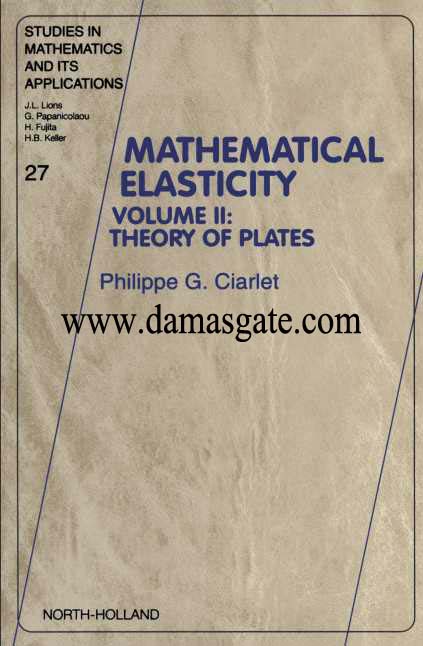Mathematical Elasticity
MATHEMATICAL ELASTICITY: GENERAL PLAN
VOLUME I: THREE-DIMENSIONAL ELASTICITY
Part A. Description of three-dimensional elasticity Chapter 1. Geometrical and other preliminaries

Chapter 2. The equations of equilibrium and the principle of vir- tual work
Chapter 3. Elastic materials and their constitutive equations Chapter 4. Hyperelasticity Chapter 5. The boundary value problems of three-dimensional
elasticity Part B. Mathematical methods in three-dimensional elasticity
Chapter 6. Existence theory based on the implicit function theo- rem
Chapter 7. Existence theory based on the minimization of the en- ergy
VOLUME II: THEORY OF PLATES
Part A. Linear plate theory Chapter 1. Linearly elastic plates
Chapter 2. Junctions in linearly elastic multi-structures Chapter 3. Linearly elastic shallow shells in Cartesian coordinates
Part B. Nonlinear plate theory
Chapter 4. Nonlinearly elastic plates Chapter 5. The von K~rm~n equations
VOLUME III: THEORY OF SHELLS
(intended table of contents)
Part A. Linear shell theory Chapter
Chapter Chapter Chapter
Chapter Chapter Chapter
1. Three-dimensional linearized elasticity in curvilinear coordinates
2. Korn inequalities on surfaces in R a 3. Linearly elastic flexural shells 4. Linearly elastic membrane shells
5. Linearly elastic generalized membrane shells 6. Koiter's equations for a linearly elastic shell 7. Linearly elastic shallow shells in curvilinear coordi-
nates Part B. Nonlinear shell theory
Chapter 8. Three-dimensional nonlinear elasticity in curvilinear coordinates
Chapter 9. Nonlinearly elastic membrane shells Chapter 10. Nonlinearly elastic flexural shells Chapter 11. Other nonlinear shell theories
MATHEMATICAL ELASTICITY: GENERAL PREFACE 1
This book, which comprises three volumes, is intended to be both
a thorough introduction to contemporary research in elasticity and a
working textbook at the graduate level for courses in pure or applied mathematics or in continuum mechanics.
During the past decades, elasticity has become the object of a considerable renewed interest, both in its physical foundations and in its mathematical theory. One reason behind this recent attention is that it has been increasingly acknowledged that the classical linear equations of elasticity, whose mathematical theory is now firmly es- tablished, have a limited range of applicability, outside of which they should be replaced by the genuine nonlinear equations that they in
effect approximate.
Another reason, similar in its principle, is that the validity of the classical lower-dimensional equations, such as the two-dimen- sional von K~rm~n equations for nonlinearly elastic plates or the two- dimensional Koiter equations for linearly elastic shells, is no longer left unquestioned. A need has been felt for a better assessment of their relation to the corresponding three-dimensional equations that they are supposed to "replace".
Download
http://s18.alxa.net/s18/srvs2/01/Mat...Elasticity.rar